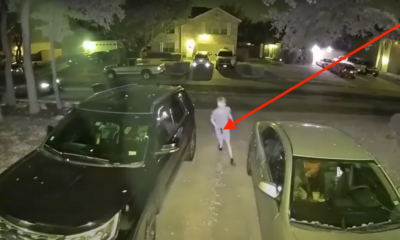Preparedness
Good Samaritan Saves Trooper in Harrowing Interstate Confrontation

A recent incident on Interstate 49 in Rogers, Arkansas, has brought to light the dangers faced by state troopers and the critical role of Good Samaritans. On July 27, 26-year-old Guatemalan national Angel Zapet-Alvarado was recorded on dashcam video resisting arrest after being pulled over for driving at a staggering 114 miles per hour in heavy traffic.
Arkansas State Police released the dashcam footage on Wednesday, showing the tense moments that unfolded when Trooper Alexandria Duncan attempted to stop Zapet-Alvarado. Despite her emergency lights and sirens, he initially refused to pull over.
After finally stopping on the highway shoulder, Zapet-Alvarado continued to defy Duncan’s commands. Duncan observed his hand on the gearshift and took his keys to prevent him from fleeing. However, he resisted exiting the vehicle, prompting Duncan to deploy her taser.
The dashcam video captures Zapet-Alvarado’s persistent refusal to comply with Duncan’s orders to roll over and put his hands behind his back. In response, Duncan triggered the taser multiple times, causing Zapet-Alvarado to cry out in pain.
At one point, Zapet-Alvarado managed to wrestle the taser from Duncan and threw it into interstate traffic. He then escalated the confrontation by kicking Duncan’s head multiple times.
Amid the struggle, 31-year-old Kylie Sutton, a Good Samaritan, rushed to assist Duncan. Upon noticing Sutton, Duncan instructed her to retrieve the taser, which Sutton did. However, Zapet-Alvarado managed to get on top of Duncan.
Sutton intervened by grabbing Zapet-Alvarado from behind and moving him to the ground. Duncan then instructed Sutton to step back and warned Zapet-Alvarado that she would shoot if he continued to resist. When he did not comply, Duncan fired a single round, wounding him in the right temple.
Despite his injury, Zapet-Alvarado continued to resist arrest until another state trooper arrived to assist Duncan. Zapet-Alvarado was then transported to Mercy Hospital Northwest Arkansas for treatment before being released to law enforcement.
Toxicology reports revealed that Zapet-Alvarado’s blood-alcohol level was .16, twice the legal limit, and that cannabinoids were present in his system. He was subsequently taken to the Benton County Sheriff’s Office Detention Center and placed on hold for a Homeland Security Investigation.
Trooper Duncan sustained non-life-threatening injuries during the altercation and received medical treatment. The state police Criminal Investigation Division reviewed the case, and Benton County Prosecutor Joshua Robinson confirmed that Duncan’s use of deadly force was consistent with Arkansas law.
Col. Mike Hagar expressed his support for Trooper Duncan, stating, “I wholeheartedly support Trooper Duncan. We tell our troopers to trust their instincts and lean into their experience and training when they’re on the highways. Anyone who has walked in a trooper’s boots knows that trusting your gut keeps you safe so that you can protect and serve the public. In our world, hesitation can get you killed.”
Hagar also praised the bravery of both Duncan and Sutton, adding, “I thank God that he gave Alex the strength to survive that encounter, and that he put Kylie by her side when she needed support the most. I’m so proud of them both.”
This incident underscores the unpredictable and perilous nature of law enforcement duties and highlights the importance of community support in ensuring the safety of officers and the public.
Watch footage of the incident below:
Let us know what you think, please share your thoughts in the comments below.

Preparedness
5 Things in Your Home That Can Help You Create a Safe Escape Plan

Not every dangerous moment involves a direct confrontation. Sometimes the real threat is confusion, panic, or not knowing what to grab when you need to react fast. Your home already has simple items that can help you stay oriented, stay calm, and get out safely if something goes wrong — whether it’s a break-in, a fire, or any unexpected emergency.
Here are five everyday things that can quietly strengthen your safety plan without feeling like “preparedness gear.”
1. A Pair of Shoes You Can Slip On Fast
This sounds almost too simple, but it’s one of the most overlooked safety tools in any house.
If you need to leave in a hurry — even just to get outside and call for help — you don’t want to waste time with laces or walk barefoot over broken glass, cold pavement, or debris. Keep a sturdy slip-on pair by your bed. It’s a small habit that can make a huge difference.
2. A Charged Old Phone
Even a disconnected phone can still call 911.
If you have an old smartphone in a drawer, charge it and leave it in your bedroom or a hidden spot. During an emergency, your main phone might be out of reach, dead, or taken. Having a backup gives you a second chance to call for help.
3. A Mini Flashlight on Your Nightstand
Power outages often happen at the worst moments. A small flashlight helps you see where you’re stepping, find your keys, or check on a noise without stumbling around in the dark. It also helps you avoid tripping hazards if you need to move quickly. Choose a compact LED one and keep it in the same spot every night.
4. A Loud Whistle
If you can’t shout, or your voice doesn’t carry far, a whistle can be your lifeline.
It cuts through walls, hallways, and even outdoor distance better than yelling. Whether you’re trying to alert a neighbor, scare off an intruder, or signal for help during a medical emergency, a whistle is one of the most underrated tools for personal safety.
5. A Written “Quick Escape Plan”
You don’t need blueprints — just a simple index card taped inside a drawer or next to your nightstand.
Write down:
• Your fastest exit routes
• Where your keys always stay
• Where your phone and flashlight stay
• A reminder to put on shoes
• Who to call first
In a panic, people forget steps. A small card keeps your mind focused and your actions clear.
Final Thought
Self-protection starts long before danger shows up. It’s not about preparing for a fight — it’s about preparing to move, think, and react in a way that keeps you safe.
Preparedness
5 Everyday Items in Your Home That Can Help You Protect Yourself

Most people don’t keep traditional self-defense tools around the house, but that doesn’t mean you’re helpless in an emergency. The truth is, you already own simple items that can give you precious seconds to get away, call 911, or draw attention. The key is knowing what works, what’s legal, and how to use these items only to defend yourself when you have no other choice.
Here are five practical household items that can help you stay safe during a threatening situation:
1. A Heavy-Duty Flashlight
A solid, metal flashlight is one of the best non-lethal tools you can keep within reach.
It serves two purposes:
• The bright beam can disorient someone long enough for you to escape.
• The sturdy body gives you something to hold if you need to keep distance between yourself and a threat.
Keep one by your bed and another near your front door.
2. A Loud Personal Alarm or Air Horn
Sometimes the strongest defense is noise. A personal alarm or small air horn can draw attention fast and frighten off an intruder. These devices are inexpensive, easy to use, and require no physical strength. They also alert neighbors that something is wrong, which can shorten response time dramatically.
3. A Strong Walking Cane
For older adults especially, a cane can be surprisingly effective for self-defense if absolutely needed. Its length helps you create distance, and its solid structure gives you a way to push someone back without having to get close. Even if you don’t use a cane daily, keeping one near your bedroom can be smart.
4. A Fire Extinguisher
Beyond its intended use, a fire extinguisher can help you defend yourself in two ways:
• The blast of spray can temporarily block vision and breathing, allowing you to escape.
• Its weight gives you something sturdy to hold while you retreat.
Plus, it’s already a safety essential for your home.
5. A Kitchen Pan or Lid
If you’re caught in the kitchen, a heavy pan or even a metal pot lid can create an effective barrier. A lid works like a small shield, helping you protect your face and upper body as you move away. A pan gives you something solid to hold between you and a threat.
A Final Note on Safety
Self-defense is always about getting away safely, not engaging in a fight. Your first options should always be:
• Avoid the situation
• Lock or barricade a door
• Call for help
• Get to safety
Use objects only as a last resort and only to give yourself time to escape.
Preparedness
5 Things You Should Always Carry During a Winter Storm

When a winter storm rolls in, life can shift fast. Roads freeze, power lines drop, and long errands suddenly become real risks. The good news is that a little preparation goes a long way, especially if you keep a few essential items within reach. These aren’t expensive or complicated. They’re simple, practical tools that can make all the difference when temperatures drop and help arrives slowly.
Below are five things worth carrying with you any time severe winter weather is in the forecast. Think of them as your personal insurance plan — small items that bring peace of mind in uncertain conditions.
1. A Fully Charged Portable Power Bank
If you’re stranded or delayed, your phone becomes your lifeline. It lets you call for help, follow weather alerts, and use GPS if you need to find your way. In cold weather, phone batteries drain much faster, so a reliable power bank is a must. Choose one that can charge your phone at least twice. Keep it in an inside pocket so cold temperatures don’t sap its power.
2. An Emergency Blanket
These lightweight, reflective blankets take up almost no space, but they retain an incredible amount of body heat. If your car breaks down or you get stuck outdoors, an emergency blanket helps you stay warm enough until help arrives. For older adults especially, preventing a rapid drop in body temperature is critical. Toss one in your glove box or day bag — you won’t notice it until you really need it.
3. High-Energy Snacks
In extreme cold, your body burns calories faster to stay warm. Carrying a small stash of calorie-dense snacks gives you steady energy and helps maintain body temperature. Look for items that won’t freeze rock-solid, such as nut butters, protein bars, granola, or trail mix. If you take medication that requires food, this becomes even more important.
4. A Compact LED Flashlight
Winter storms often come with poor visibility. Whether you’re navigating an icy path, checking under the hood, or signaling for help, a bright flashlight is worth its weight in gold. Choose an LED model with long battery life, and avoid relying solely on your phone’s flashlight. You may need that battery for communication.
5. A Small First-Aid Pouch
Accidents are more common when surfaces are slick. A small kit with bandages, antiseptic wipes, medical tape, hand warmers, and any personal medications can stabilize minor injuries until you can get proper care. Add a pair of disposable gloves to protect your hands in freezing weather.
Preparing for winter doesn’t mean living in fear. It simply means respecting the season and giving yourself the tools to stay safe, warm, and steady. With these five essentials on hand, you’ll be better equipped to handle whatever a winter storm throws your way — and you’ll travel with much more confidence as the temperatures fall.
-

 Tactical2 years ago
Tactical2 years ago70-Year-Old Fends Off Intruder with Lead-Powered Message
-

 Tactical2 years ago
Tactical2 years agoVape Shop Employee Confronts Armed Crooks, Sends Them Running
-

 Preparedness1 year ago
Preparedness1 year agoEx-Ballerina’s Guilty Verdict Sends Tremors Through Gun-Owner Community
-

 Off The Grid1 month ago
Off The Grid1 month ago10 Foods That Could Save Your Life When Grocery Shelves Are Empty
-

 Tactical2 years ago
Tactical2 years agoMidnight SUV Theft Interrupted by Armed Homeowner’s Retaliation
-

 Preparedness5 months ago
Preparedness5 months agoHow Much Gasoline Should You Store for Emergencies?
-

 Nature and Wildlife4 weeks ago
Nature and Wildlife4 weeks ago10 Survival Skills You Should Learn Before You Need Them
-

 Survival Stories2 years ago
Survival Stories2 years agoEmily’s 30-Day Experience of Being Stranded on a Desert Island
Holly
October 2, 2024 at 2:31 pm
Perfect example why women should not be police. Men have a hard enough time subduing criminals.
Bob Kirin
October 2, 2024 at 3:19 pm
Not too many people will stop to help police, or anyone else, because they could be charged like the guy in the train stopping a nut from threatening other passengers. That is new behavior of so called justice!!!
Paul
October 2, 2024 at 5:29 pm
She obviously needs better grappling skills, and better aim! How many men drove past that should have stopped to help? We’re in a world full of pansies! Thanks to the woman that stopped, she should have zapped the crap out of him, but at least she helped!
Chad
December 14, 2024 at 12:47 pm
Police put themselves on the line every day for civilians .Its hard to fathom that a young woman stopped to help but no men .
I’ve worked with police agencies ( as a consultant ,advisor) and is amazing how they don’t receive enough support from people.
Alexander Sozansky
January 24, 2025 at 2:37 pm
she had him stopped and should have waited for backup to help her after the initial tussle. she did an awesome job just ganging on to him m. praise the Lord for the lady that stopped to help